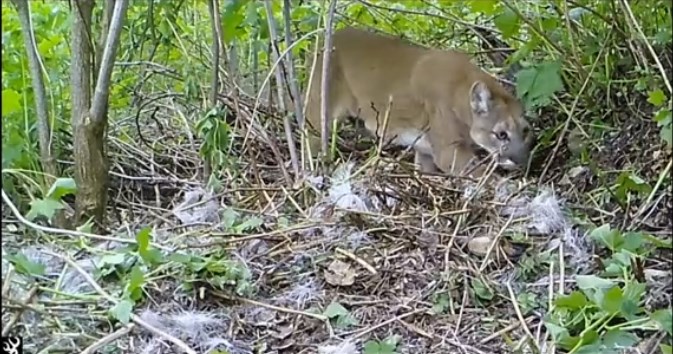
Image Credit: FACEBOOK/WildSafeB.C.
May 22, 2021 - 4:30 PM
The circle of life has been caught on camera with both a cougar and bear making the most out of a deer carcass.
A WildSafeB.C. Bella Coola co-ordinator set up a camera next to a fresh cougar kill last week.
A few days later she returned to a full memory card and found that both an adult female cougar likely killed the deer and buried it to return to it later on.
“Cougars will make concerted efforts to hide their kills from other predators and scavengers by covering the carcass with surrounding vegetation to conceal the sight and smell. They will then return to the kill site to dig it up and feed further. Depending on the prey species killed they may visit the same kill site for many days or even weeks,” according to a Facebook post from WildSafeB.C.
The cougar is accompanied by an eight to 12-month-old kitten.
Cougars are often susceptible to kleptoparasitism, where one species feeds or takes from the kill made by another species and will therefore remain vigilant to the presence of other predators while at their kill. Mothers and young are especially at risk from bears and wolves stealing their kills and possibly injuring any kittens in the process, according to Wildsafe’s post.
After the mother and daughter had their fill a grizzly bear boar came to scavenge the remains the following day. Having recently emerged from denning, finding and scavenging kills is important for bears during this time of year as they attempt to regain body condition.
Researchers in Colorado and Northern California studied the effects of kleptoparasitism on cougars by bears and how cougars mitigate risks.
They discovered that rather than attempting to spatially avoid bears, cougars instead increased their weekly kill rates by more than 48% during bear season compared with no-bear season, according to WildSafe.
“Interactions between predators in the coastal rainforest system, such as that of Bella Coola, is still little understood so footage such as this is incredibly informative and demonstrates the cascading impacts different species have on one another within an ecological community,” according to WildSafeB.C.
To contact a reporter for this story, email Carli Berry or call 250-864-7494 or email the editor. You can also submit photos, videos or news tips to the newsroom and be entered to win a monthly prize draw.
We welcome your comments and opinions on our stories but play nice. We won't censor or delete comments unless they contain off-topic statements or links, unnecessary vulgarity, false facts, spam or obviously fake profiles. If you have any concerns about what you see in comments, email the editor in the link above.
News from © iNFOnews, 2021